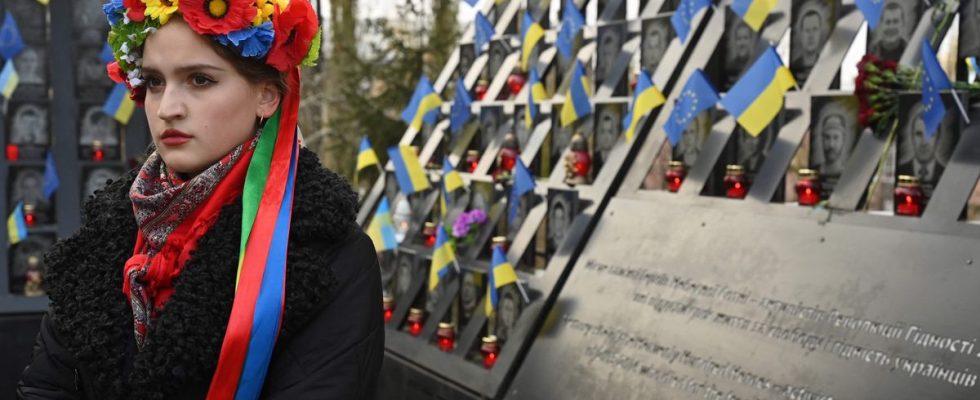Cold and memory envelop kyiv’s Independence Square. In front of the steles lined up opposite in tribute to the Maidan activists, many Ukrainians, moved, laid wreaths of yellow carnations this Tuesday. Ten years after the Dignity Revolution – often nicknamed the Maidan Revolution after the name of this central square, some young women go there wearing a Ukrainian crown (vinok). A floral emblem of Ukrainian identity which echoes these pro-European demonstrations and their essential role in the destiny of Ukraine.
Because this event, which shook the country from November 2013 to February 2014, is “a turning point which completely changed the course of the country’s history”, assures Carole Grimaud, expert at the Geneva Geostrategic Observatory and founder of the Center. research on Russia and Eastern Europe (CREER). From November 2013, hundreds of thousands of Ukrainians gathered in this square to oppose the president at the time, the pro-Russian Viktor Yanukovych.
“On that day, Ukraine turned away from Russia”
The leader suddenly decided to suspend an association agreement between Ukraine and the European Union, provoking the ire of part of the population. After several weeks of protest, he ordered the police to open fire, causing the deaths of nearly a hundred demonstrators. A bloody repression which put the last nail in the coffin of the government and forced the leader subservient to Moscow to flee the country in disaster.
“For Ukrainians, Maidan is a memory of unity, hope and even joy, at the beginning, even if it ended tragically,” analyzes Dorota Dakowska, professor of political science at Sciences po Aix. However, not all regions of Ukraine “experienced this event in the same way, the Ukrainian population being very divided”, recalls Carole Grimaud. This was before the Russian invasion united an entire people behind its president and warlord.
Volodymyr Zelensky spoke to commemorate this event, referring to Ukraine’s very “first victory” in its war against the Russian invader. “Ukrainians wanted to decide their own destiny. It was not the first movement in this direction – we remember the Orange Revolution in 2004, but it was during the Maidan Revolution that the population understood that they had to choose between dependence on Russia and a future directed towards the European Union”, deciphers Dorota Dakowska. “That day, Ukraine turned away from Russia,” adds Carole Grimaud, who adds that it is for this reason that the Maidan uprising represents “a European turning point” in the recent history of the country.
The “ground zero” of the conflict
The symbolic weight of this turn to the west is all the more powerful today, as Ukrainians fight for their survival. “The Ukrainians very quickly paid the price for this demand for rapprochement with the European Union,” recalls Dorota Dakowska. In April 2014, less than two months after the end of the February Revolution, Moscow attacked Donbass and quickly and illegally annexed Crimea. “We can consider that the Maidan uprising is the beginning of a long war which has never really ended since 2014”, analyzes Carole Grimaud who adds “it is the ground zero of this conflict which we are witnessing today “.
But also the starting point of the Ukrainian government’s desire to integrate the European Union and NATO, in the hope of definitively protecting itself from the imperialist assaults of Moscow. The ten years of the Maidan uprising are also an opportunity for Volodymyr Zelensky to remind the European Union how much the Ukrainians hope to join it. This Tuesday, the head of state asked for a “result” in December on his membership request. The President of the European Council Charles Michel hastened to promise that he would work to convince the member states, adding that the Union had a “moral duty” towards Ukraine.
“Ready to die to get closer to the EU”
“The Maidan uprising is essential to understand the support that European institutions offer kyiv. It is not common to see people ready to die to get closer to the European Union. For the values of freedom and democracy that it represents,” underlines Dorota Dakowska, who recalls that several European leaders traveled in 2013 to meet the actors of this “Revolution of Dignity”. “It was quite touching for Westerners and in particular for Europeans. It’s hard to imagine the French demonstrating for a European treaty,” says the political science professor with a smile.
Ten years later, Vladimir Putin has not forgotten this affront and has intensified the scale of his war against Ukraine. Faced with this observation, kyiv chose insurrection. From Maidan Square in 2013, to the whole country today. “There is a well-known saying in Ukraine: ‘If Russia stops fighting, there is no more war. But if Ukrainians stop fighting, there is no more Ukraine,’” Dorota concludes Dakowska.

